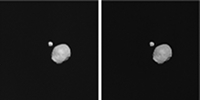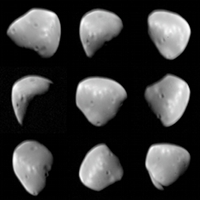Martian moon: Deimos
 |
|
Phobos and Deimos raw (left panel) and processed images (right panel). Credit: ESA/DLR/FU Berlin (G. Neukum) |
Deimos has an equatorial, almost circular, orbit. It orbits once every 30h 18 minutes at
Despite remote sensing investigation by Mars Express, Mars Reconnaissance Observer and Mars Global Surveyor, the composition of Deimos has not been resolved. The composition is a key indicator in the search for the origins of Deimos and Phobos. Data from the Mars Express OMEGA spectrometer suggest that Deimos has a primitive composition. Like Phobos, Deimos is thought to be quite porous.
 |
|
SRC images of Deimos obtained from different orbits. Credit: ESA/ DLR/FU Berlin (G. Neukum) |
Mars Express has made close approaches of Deimos, taking images with its High Resolution Stereo Camera from distances of
Understanding the formation of the Martian moons would contribute to the overall understanding of the formation of the Solar System. Scientists from ESA are studying a possible sample return mission to Phobos.
| Key parameters for Deimos | |
| Parameter | Deimos |
| Average distance from centre of Mars | 23 458 km |
| Average distance from surface of Mars | 20 068 km |
| Dimensions | 7.5 × 6.1 × 5.2 km |
| Mass | 1.5 × 1015 kg |
| Rotational Period | Synchronous |
| Orbital Period | 1.26 days (30 h 18 min) |
| Orbital Eccentricity | 0.00024 |
| Orbital Inclination | 1.8° |
| Parameters in this table are taken from Rosenbatt 2011 and references therein | |




